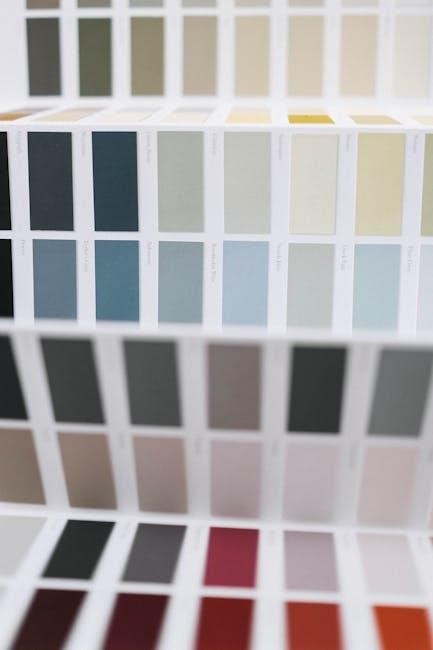Bleaching shade guides are essential tools in dentistry, enabling precise tooth color determination for whitening treatments․ They ensure natural-looking results by categorizing shades systematically, enhancing diagnostic and treatment accuracy․
Overview of Tooth Shade Guides in Dentistry
Tooth shade guides are systematic tools used in dentistry to accurately match tooth colors for restorative and cosmetic procedures․ They categorize tooth shades based on brightness, chroma, and hue, ensuring consistent results․ These guides are essential for both natural and bleached tooth shades, aiding in precise shade determination․ Portable and easy to use, they are indispensable in clinical settings, helping dentists achieve aesthetically pleasing and consistent outcomes for patients undergoing teeth whitening or restorative treatments․
Importance of Accurate Shade Matching in Teeth Whitening
Accurate shade matching is crucial for achieving natural-looking results in teeth whitening․ It ensures that the final tooth color aligns with patient expectations and aesthetic goals․ Inaccurate matching can lead to unsatisfactory outcomes, affecting both the patient’s appearance and confidence․ By using bleaching shade guides, dentists can precisely determine the desired shade, ensuring consistent and predictable results․ This attention to detail enhances patient satisfaction, builds trust, and contributes to the overall success of the whitening treatment․

Types of Bleaching Shade Guides
Various bleaching shade guides are available, each offering unique features․ Popular options include VITA 3D Master, VITA Toothguide 3D-MASTER, Vita Bleachedguide 3D-Master, AD Shade Guide, EZGO Professional 3D R-20, and VITA Classical with Bleached Shades, catering to different clinical needs․
VITA 3D Master Bleach Shade Guide
The VITA 3D Master Bleach Shade Guide is a state-of-the-art tool for accurate tooth shade determination, incorporating advanced chromatology․ It systematically organizes shades based on brightness, chroma, and hue, ensuring precise and reproducible results․ Designed for both natural and bleached teeth, it includes intermediate shades for enhanced accuracy․ Its portability and user-friendly design make it ideal for clinical settings, allowing dentists to plan and monitor whitening treatments effectively․ This guide is a reliable choice for achieving consistent and aesthetically pleasing outcomes in teeth whitening procedures․
VITA Toothguide 3D-MASTER with Bleached Shades
The VITA Toothguide 3D-MASTER with Bleached Shades is an advanced tool designed for precise shade determination in dental aesthetics․ It combines 26 natural tooth shades with 3 bleached shades, offering a comprehensive range for both standard and whitening cases․ The guide uses a three-parameter system—brightness, chroma, and hue—to ensure accurate results․ Its user-friendly design allows for quick and reproducible shade matching, making it a valuable asset in clinical settings for achieving optimal aesthetic outcomes in tooth whitening and restorative procedures;

Vita Bleachedguide 3D-Master
The Vita Bleachedguide 3D-Master simplifies tooth whitening planning and monitoring with its advanced chromatic system․ It defines shades using brightness, chroma, and hue, ensuring precise measurements․ The guide includes intermediate tabs for enhanced accuracy, making it ideal for tracking bleaching progress․ Its portability and ease of use in clinical settings make it a reliable tool for dentists․ This guide integrates seamlessly with other dental tools, offering a comprehensive solution for achieving consistent and desired whitening results efficiently․
AD Shade Guide for Bleached Teeth
The AD Shade Guide for Bleached Teeth is a practical instrument for selecting tooth shades according to the AD and Bleach shade system․ It features 16 basic shades grouped into categories A, B, C, and D, supplemented by four modern Bleach shades (BL1 to BL4)․ This guide is designed for easy use by dentists and dental technicians, offering a reliable tool for matching natural and bleached tooth colors․ Its simplicity and effectiveness make it an essential resource for achieving accurate and consistent results in dental procedures․
EZGO Professional 3D R-20 Dental Whitening Shade Guide
The EZGO Professional 3D R-20 Dental Whitening Shade Guide is a portable and user-friendly tool designed for tracking teeth whitening progress․ It features 20 distinct shades with laser-engraved numbering, allowing for precise color matching and monitoring․ The guide is specifically tailored for dental professionals, offering a reliable method to document and communicate tooth color changes during bleaching treatments․ Its compact design and ease of use make it an ideal solution for clinical and aesthetic dental procedures, ensuring accurate and consistent results․
VITA Classical Dental Shade Guide with Bleached Shades
The VITA Classical Dental Shade Guide with Bleached Shades combines traditional accuracy with modern innovations․ It includes 16 natural tooth shades and additional bleached options, offering a comprehensive range for both natural and whitened teeth․ The guide arranges shades by value, chroma, and hue, ensuring precise color matching․ Its design integrates seamlessly with other VITA systems, making it a versatile tool for dentists․ The inclusion of bleached shades enhances its utility in aesthetic and restorative dental procedures, providing reliable and consistent results for patients seeking natural-looking smiles;

Features and Benefits of Modern Shade Guides
Modern shade guides offer advanced chromatology, portability, and ease of use․ They include intermediate tabs for precision, ensuring accurate and consistent tooth color determination in clinical settings․
Advanced Chromatology for Precise Shade Determination
Modern shade guides utilize advanced chromatology, incorporating brightness, chroma, and hue parameters for precise tooth color matching․ This three-parameter system ensures accurate and reproducible results, enhancing diagnostic capabilities․ The inclusion of intermediate shades further refines color determination, allowing for subtle distinctions․ These tools are calibrated to reflect natural tooth color variations, making them indispensable for both natural and bleached tooth assessments․ Their portability and ease of use in clinical settings streamline the whitening process, ensuring consistent and reliable outcomes for dental professionals․
Three-Parameter System: Brightness, Chroma, and Hue
The three-parameter system in modern shade guides categorizes tooth colors based on brightness (lightness), chroma (saturation), and hue (actual color tone)․ This comprehensive approach ensures precise shade determination by breaking down complex color variations into measurable components․ Brightness determines how light or dark a tooth appears, while chroma assesses color intensity, and hue identifies the specific shade tone․ Together, these parameters allow for accurate and reproducible shade matching, making them vital for both natural and bleached tooth assessments in dental procedures․

Inclusion of Intermediate Shade Tabs for Enhanced Precision
Intermediate shade tabs in modern bleaching shade guides provide enhanced precision by offering additional color gradations between standard shades․ These tabs help bridge gaps in the color spectrum, ensuring more accurate shade determination, especially for subtly varying tooth colors․ By including these intermediate options, shade guides improve the reliability of color matching during teeth whitening procedures․ This feature is particularly useful for monitoring progress and achieving desired aesthetic outcomes, as it allows for finer adjustments and more personalized treatment plans tailored to individual patient needs․
Portability and Ease of Use in Clinical Settings
Modern bleaching shade guides are designed with portability and ease of use in mind, making them ideal for clinical applications․ Their lightweight and compact design allows dentists to transport them effortlessly between treatment rooms․ Many guides feature ergonomic holders or clips, enabling quick and efficient shade determination․ This practical design ensures minimal disruption to workflow, while the intuitive layout simplifies the process of matching tooth shades․ Such features enhance productivity and convenience, making shade guides indispensable tools in dental practices․

How to Use a Bleaching Shade Guide
Bleaching shade guides are used to determine tooth color by comparing teeth to standardized shades․ They help monitor progress and achieve desired whitening outcomes efficiently․
Step-by-Step Process for Shade Determination

Start by ensuring the teeth are clean and dry for accurate color assessment․ Under natural light, compare the teeth with the shade guide, beginning with the middle shades․ Narrow down the options by evaluating brightness, chroma, and hue․ Select the closest match, considering any discrepancies․ Document the initial and target shades for monitoring progress․ Modern guides like the VITA 3D Master use a three-parameter system for precise determination․ This method ensures consistency and reliability in achieving desired whitening outcomes, enhancing both treatment accuracy and patient satisfaction․
Monitoring Progress During Teeth Whitening
Regular monitoring using a bleaching shade guide ensures precise tracking of tooth color changes during whitening treatments․ By comparing initial and current shades, dentists can assess progress and adjust treatment plans․ The guide’s portability allows for consistent comparisons in clinical or remote settings․ Documenting shade changes helps maintain transparency with patients, showcasing improvements․ Advanced guides, like the EZGO Professional 3D R-20, feature numbered shades for easy tracking․ Proper storage and handling of the guide ensure accuracy over repeated use, making it an indispensable tool for achieving optimal whitening results and patient satisfaction․
Combining Shade Guides with Other Dental Tools
Bleaching shade guides are often integrated with digital dentistry tools and CAD/CAM systems for enhanced accuracy․ They complement prosthetic and orthodontic treatments by ensuring color consistency․ Portable guides like the EZGO Professional 3D R-20 align with chairside systems, streamlining workflows․ Combining shade guides with imaging software allows for precise pre- and post-treatment comparisons․ This integration ensures seamless communication between dentists and technicians, optimizing aesthetic outcomes․ By pairing shade guides with advanced technologies, clinicians achieve more predictable and satisfying results for patients undergoing whitening or restorative procedures․
Maintenance and Storage of Shade Guides
Proper cleaning with soft cloths and storage in protective cases preserve shade guide accuracy․ Avoid harsh chemicals and extreme temperatures to maintain color integrity and longevity․
Best Practices for Longevity
Regularly clean shade guides with soft, dry cloths to prevent dust buildup․ Avoid harsh chemicals or abrasive materials that might damage the surface․ Store them in protective cases to shield from environmental factors like moisture and light․ Handle guides gently to prevent scratches or bending․ Keep them away from extreme temperatures, as this can alter color accuracy․ By following these practices, you ensure the longevity and reliability of your bleaching shade guide, maintaining its precision for consistent dental treatments․
Calibration and Accuracy Over Time
Shade guides require periodic calibration to maintain accuracy․ Exposure to light and handling can cause colors to fade, affecting reliability․ Regular comparisons with master references ensure consistency․ Dentists should recalibrate guides every six months or when noticeable color shifts occur․ Proper storage in protective cases minimizes environmental impact․ Additionally, using standardized lighting conditions during shade matching helps preserve accuracy․ Regular maintenance ensures that your bleaching shade guide remains a reliable tool for precise tooth color determination and effective treatment outcomes․
Factors Influencing Tooth Shade Selection
Natural tooth color variations, bleaching impacts, and patient preferences significantly influence shade selection; Genetics, aging, and staining affect natural shades, while bleaching alters colors predictably but variably․
Natural Tooth Color Variations
Natural tooth color variations are influenced by genetics, aging, and environmental factors like staining․ Teeth range from light to dark shades, categorized into groups such as A (reddish-brown), B (reddish-yellow), C (gray), and D (reddish-gray)․ These variations are systematically organized in shade guides to aid accurate matching during dental procedures, ensuring natural-looking outcomes for restorations or bleaching treatments․ Understanding these variations is crucial for achieving aesthetically pleasing results that align with patient expectations and dental standards․
Impact of Bleaching on Tooth Color
Bleaching significantly alters tooth color by reducing chroma and increasing brightness․ It shifts teeth to lighter shades, often achieving a more uniform appearance․ Shade guides track these changes, ensuring predictable outcomes․ While results vary, modern systems integrate bleached shades to help dentists monitor progress effectively․ Accurate documentation using guides enhances treatment reliability, ensuring patient satisfaction and optimal aesthetic results in teeth whitening procedures․
Patient Preferences and Aesthetic Goals
Patient preferences play a crucial role in tooth whitening outcomes, as aesthetic goals vary widely․ Shade guides help align treatments with individual desires, ensuring results that match expectations․ Whether patients seek natural-looking shades or dramatic transformations, modern guides offer flexibility․ By integrating bleached shades, these tools enable precise matching to desired aesthetics․ Effective communication between dentists and patients is facilitated, ensuring satisfaction and personalized outcomes․ Shade guides thus serve as essential connectors between clinical precision and patient-driven cosmetic objectives in teeth whitening procedures․

Comparison with Other Dental Shade Guides
Bleaching shade guides like VITA and AD systems offer advanced chromatology, unlike traditional guides․ VITA’s 3D Master system provides superior precision, while AD focuses on simplicity, catering to different clinical needs․
VITA vs․ AD Shade Systems
The VITA and AD shade systems are two prominent tools in dentistry, each offering unique advantages․ The VITA system, particularly its 3D Master series, provides a comprehensive chromatic range with 26 natural shades and 3 bleached options, organized by brightness, chroma, and hue․ In contrast, the AD system simplifies shade selection with 16 basic shades and 4 bleached additions, making it more straightforward for general applications․ While VITA excels in precision and versatility, AD is favored for its ease of use and practicality, catering to different clinical preferences and patient needs․
Classical vs․ 3D Master Systems
Classical vs․ 3D Master Systems
The Classical and 3D Master systems differ significantly in their approach to tooth shade matching․ The Classical system offers 16 natural shades, arranged by hue and chroma, providing a straightforward, traditional method․ The 3D Master system, however, incorporates a three-dimensional approach, categorizing shades by brightness, chroma, and hue, allowing for more precise and nuanced color matching․ While the Classical system is simple and widely used, the 3D Master system is preferred for complex cases requiring higher accuracy and customization in dental aesthetics․

Benefits of Using Bleaching Shade Guides
Bleaching shade guides enhance patient satisfaction, improve treatment outcomes, and streamline dental procedures by providing accurate and consistent tooth color determination, ensuring natural aesthetics and efficient results․
Enhanced Patient Satisfaction
Bleaching shade guides significantly boost patient satisfaction by ensuring natural-looking results that align with aesthetic expectations․ Accurate shade matching leads to predictable outcomes, minimizing revisions and enhancing trust in dental care․ Patients appreciate the ability to visualize and discuss desired results, fostering better communication․ The guides also streamline the whitening process, reducing anxiety and ensuring a personalized approach․ Achieving desired tooth color improves self-confidence, which is a key factor in patient satisfaction, making bleaching shade guides an invaluable tool for both dentists and patients seeking optimal cosmetic outcomes․
Improved Treatment Outcomes
Improved Treatment Outcomes
Bleaching shade guides enhance treatment outcomes by ensuring precise shade determination, minimizing the need for adjustments․ They allow dentists to monitor progress accurately, achieving consistent and predictable results․ Advanced chromatology and three-parameter systems (brightness, chroma, hue) enable tailored whitening plans, reducing discrepancies․ This precision leads to better color matching, reducing the risk of over- or under-bleaching․ Consequently, patients achieve their desired aesthetic goals more efficiently, resulting in higher-quality outcomes and greater overall satisfaction with their dental care experience․
Streamlined Dental Procedures
Bleaching shade guides streamline dental procedures by providing a standardized and efficient method for shade determination․ Their portability and ease of use allow dentists to quickly assess and document tooth colors, reducing time spent on shade matching․ The systematic approach of these guides minimizes errors and ensures consistency, enabling a more efficient workflow․ Additionally, the inclusion of intermediate shades and advanced chromatology features simplifies the process, making it easier for dental teams to achieve accurate and reliable results without unnecessary delays or repeated assessments․
Case Studies and Clinical Applications
Bleaching shade guides have proven effective in real-world applications, with documented success in teeth whitening procedures․ Clinical studies highlight significant shade changes, demonstrating their practical value in dentistry․
Success Stories in Teeth Whitening
Case studies demonstrate the effectiveness of bleaching shade guides in achieving desired results․ Many patients have experienced significant improvements, with shade changes of up to six units, leading to enhanced aesthetics and patient satisfaction․ These guides ensure predictable outcomes, making them invaluable in clinical practice․ The ability to track progress and communicate results clearly has strengthened dentist-patient trust, showcasing the practical benefits of these tools in modern dentistry․
Real-World Applications of Shade Guides
Bleaching shade guides are indispensable in daily dental operations, enhancing treatment accuracy and patient satisfaction․ They enable precise tracking of whitening progress, ensuring desired aesthetic outcomes․ These tools are widely used to monitor non-vital teeth discoloration and guide intracoronal bleaching procedures; Their portability and ease of use make them essential for dentists and technicians in clinical settings․ Additionally, shade guides are integral in restorative and prosthetic cases, providing a reliable method for achieving consistent and natural-looking results in various dental treatments․

Future Trends in Shade Guide Technology
Digital innovations and 3D printing advancements are revolutionizing shade guides, enabling precise customization and integration with digital dentistry tools for enhanced accuracy and efficiency in tooth color matching․
Digital and 3D Printing Innovations
Digital tools and 3D printing are transforming shade guides, offering customized solutions for precise tooth color matching․ Advanced software enables real-time tracking of shade changes during whitening treatments, while 3D-printed guides provide tailored templates for individual patient needs․ These innovations integrate seamlessly with CAD/CAM systems, enhancing accuracy and efficiency in dental procedures․ Digital shade guides also allow for enhanced documentation and communication between dentists and technicians, ensuring consistent and predictable outcomes for patients undergoing teeth whitening or restorative treatments․
Integration with Digital Dentistry Tools
Bleaching shade guides are increasingly integrated with digital dentistry tools, enhancing precision and efficiency․ Digital shade matching systems synchronize with intraoral scanners and CAD/CAM software, allowing real-time data transfer and accurate color reproduction․ This integration streamlines the diagnostic and treatment planning process, ensuring consistent results․ Additionally, digital tools enable seamless communication between dentists and laboratories, facilitating customized solutions for patients․ The combination of physical shade guides with digital platforms offers a comprehensive approach to achieving predictable and aesthetic outcomes in teeth whitening and restorative procedures․
Bleaching shade guides are essential for achieving accurate and aesthetic tooth whitening results, ensuring precision and patient satisfaction in modern dental practices and cosmetic procedures․
Final Thoughts on the Importance of Bleaching Shade Guides
Bleaching shade guides are indispensable in modern dentistry, ensuring precise tooth color matching for whitening treatments․ They enhance patient satisfaction by delivering natural, aesthetic results․ Their systematic approach streamlines procedures, reducing guesswork and improving outcomes․ With advancements like 3D chromatology, these tools remain vital for achieving predictable and cosmetically pleasing results․ Regular calibration ensures long-term accuracy, making them a reliable asset for dentists․ Their role in tracking progress and meeting patient expectations underscores their importance in contemporary dental care․

Leave a Reply
You must be logged in to post a comment.